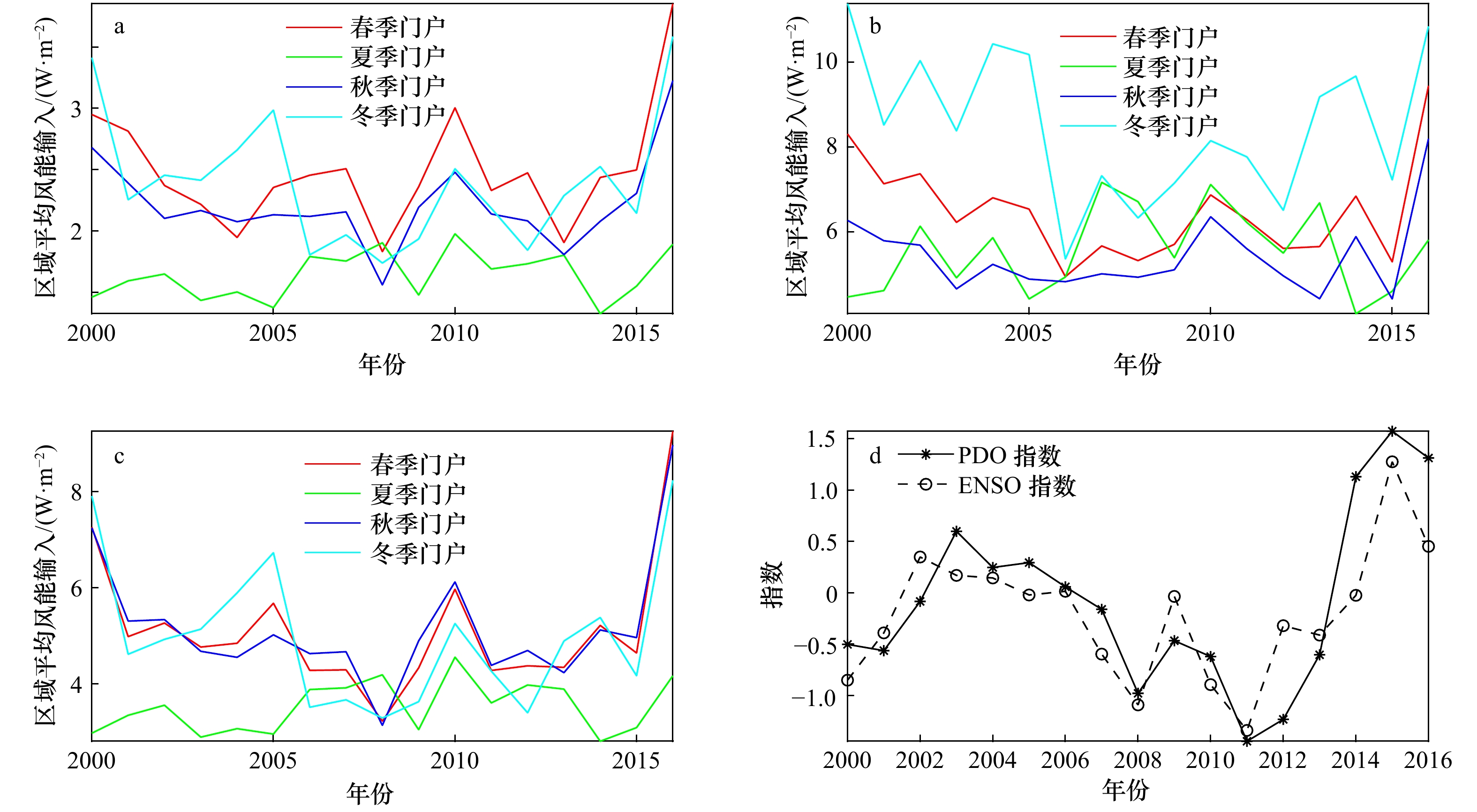North part of the North Pacific is a major gateway of wind energy into the ocean
-
摘要: 风不仅驱动了上层海洋的环流,也是深层海洋运动的主要能量来源。本文主要研究了北太平洋北部的风能输入的季节性分布特征和年际变化趋势,包括风向表面波、表层地转流和表层非地转流的能量输入。基于SODA3数据的结果表明,风能输入门户随季节变化显著,其中黑潮延伸区是冬季门户,副极地流涡是春、秋季门户,大洋东边界则是夏季门户,能量输入强度逐次递减。21世纪以来,秋冬风能输入明显减弱,春季增加,夏季无显著变化。就变化趋势的空间分布而言,向表面波的能量输入由风场主导,而向表层地转流和非地转流的能量输入则由流场主导。这些机械能输入结果对进一步认识该海域的动力机制有重要意义。Abstract: Wind not only drives the surface ocean circulations, but also provides the main source of kinetic energy for deep ocean movements. This study focuses on the wind energy input to the north part of the North Pacific, including wind energy input to surface wave, surface geostrophic currents and surface ageostrophic currents. Results based on SODA3 (2000–2016) data show that there are obvious seasonal wind energy input gateways, which are the Subpolar Gyre for spring and autumn, the Eastern Pacific for summer and the Kuroshio Extension for winter respectively. The winter gateway gains the most wind energy among the four seasonal gateways, which is about 3−5 times higher than others. Since the beginning of the 21st century, wind energy input in winter gateway has weakened significantly, while increased in spring gateway, but has not changed significantly in summer and autumn gateway. For the spatial distribution of the trend in the 17 years, wind energy input to the surface wave is mainly dominated by the wind field, while wind energy input to the surface geostrophic current and ageostrophic current is dominated by the flow field. These mechanical energy input results are important for further understanding the ocean circulations in the North Pacific.
-
Key words:
- wind energy input /
- gateway /
- surface wave /
- surface geostrophic current /
- surface ageostrophic current
-
表 1 各个季节门户内风能输入与PDO指数以及ENSO指数的相关系数
Tab. 1 Correlation between wind energy input and PDO index and ENSO index in each seasonal gateway
区域 指数 表面波 表层地转流 表层非地转流 春季门户 PDO 0.29 0.26 0.42 ENSO 0.13 0.05 0.21 夏季门户 PDO −0.35 −0.46 −0.39 ENSO −0.33 −0.44 −0.38 秋季门户 PDO 0.39 0.18 0.38 ENSO 0.24 −0.07 0.21 冬季门户 PDO 0.40 0.32 0.40 ENSO 0.15 0.14 0.14 -
[1] Wunsch C, Ferrari R. Vertical mixing, energy, and the general circulation of the oceans[J]. Annual Review of Fluid Mechanics, 2004, 36: 281−314. doi: 10.1146/annurev.fluid.36.050802.122121 [2] Wang Wei, Huang Rinxin. Wind energy input to the surface waves[J]. Journal of Physical Oceanography, 2004, 34(5): 1276−1280. doi: 10.1175/1520-0485(2004)034<1276:WEITTS>2.0.CO;2 [3] Wang Wei, Huang Ruixin. Wind energy input to the ekman layer[J]. Journal of Physical Oceanography, 2004, 34(5): 1267−1275. doi: 10.1175/1520-0485(2004)034<1267:WEITTE>2.0.CO;2 [4] Urakawa L S, Hasumi H. The energetics of global thermohaline circulation and its wind enhancement[J]. Journal of Physical Oceanography, 2009, 39(7): 1715−1728. doi: 10.1175/2009JPO4073.1 [5] Munk W, Wunsch C. Abyssal recipes II: energetics of tidal and wind mixing[J]. Deep-Sea Research Part I: Oceanographic Research Papers, 1998, 45(12): 1977−2010. doi: 10.1016/S0967-0637(98)00070-3 [6] Watanabe M, Hibiya T. Global estimates of the wind-induced energy flux to inertial motions in the surface mixed layer[J]. Geophysical Research Letters, 2002, 29(8): 64-1−64-3. [7] Huang Ruixin, Wang Wei, Liu Lingling. Decadal variability of wind-energy input to the world ocean[J]. Deep-Sea Research Part II: Topical Studies in Oceanography, 2006, 53(1/2): 31−41. [8] Teng Yong, Yang Yongzeng, Qiao Fangli, et al. Energy budget of surface waves in the global ocean[J]. Acta Oceanologica Sinica, 2009, 28(3): 5−10. [9] Liu Guoqiang, He Yijun, Zhang Yuanzhi, et al. Estimation of global wind energy input to the surface waves based on the scatterometer[J]. IEEE Geoscience and Remote Sensing Letters, 2012, 9(6): 1017−1020. doi: 10.1109/LGRS.2012.2189194 [10] Brown J N, Fedorov A V. Mean energy balance in the tropical Pacific Ocean[J]. Journal of Marine Research, 2008, 66(1): 1−23. doi: 10.1357/002224008784815757 [11] Von Storch J S, Sasaki H, Marotzke J. Wind-generated power input to the deep ocean: an estimate using a 1/10° general circulation model[J]. Journal of Physical Oceanography, 2007, 37(3): 657−672. doi: 10.1175/JPO3001.1 [12] Wunsch C. The work done by the wind on the oceanic general circulation[J]. Journal of Physical Oceanography, 1998, 28(11): 2332−2340. doi: 10.1175/1520-0485(1998)028<2332:TWDBTW>2.0.CO;2 [13] Duhaut T H A, Straub D N. Wind stress dependence on ocean surface velocity: implications for mechanical energy input to ocean circulation[J]. Journal of Physical Oceanography, 2006, 36(2): 202−211. doi: 10.1175/JPO2842.1 [14] Zhai Xiaoming, Wunsch C. On the variability of wind power input to the oceans with a focus on the subpolar north Atlantic[J]. Journal of Climate, 2013, 26(11): 3892−3903. doi: 10.1175/JCLI-D-12-00472.1 [15] Wu Kejian, Liu Bin. Stokes drift-induced and direct wind energy inputs into the Ekman layer within the Antarctic Circumpolar Current[J]. Journal of Geophysical Research: Ocearns, 2008, 113(C10): C10002. doi: 10.1029/2007JC004579 [16] Kilbourne B F, Girton J B. Quantifying high-frequency wind energy flux into near-inertial motions in the Southeast Pacific[J]. Journal of Physical Oceanography, 2015, 45(2): 369−386. doi: 10.1175/JPO-D-14-0076.1 [17] Zhai Xiaoming, Greatbatch R J. Wind work in a model of the northwest Atlantic Ocean[J]. Geophysical Research Letters, 2007, 34(4): L04606. [18] Zhu Yaohua, Fang Guohong, Wei Zexun, et al. Seasonal variability of the meridional overturning circulation in the South China Sea and its connection with inter-ocean transport based on SODA2.2. 4[J]. Journal of Geophysical Research: Oceans, 2016, 121(5): 3090−3105. doi: 10.1002/2015JC011443 [19] Carton J A, Giese B S, Grodsky S A. Sea level rise and the warming of the oceans in the Simple Ocean Data Assimilation (SODA) ocean reanalysis[J]. Journal of Geophysical Research, 2005, 110(C9): C09006. [20] Carton J A, Giese B S. A reanalysis of ocean climate using simple ocean data assimilation (SODA)[J]. Monthly Weather Review, 2008, 136(8): 2999−3017. doi: 10.1175/2007MWR1978.1 [21] Giese B S, Ray S. El Niño variability in simple ocean data assimilation (SODA), 1871–2008[J]. Journal of Geophysical Research: Oceans, 2011, 116(C2): C02024. [22] Yang Haiyuan, Wu Lixin. Trends of upper-layer circulation in the South China Sea during 1959–2008[J]. Journal of Geophysical Research: Oceans, 2012, 117(C8): C08037. -





 下载:
下载:





